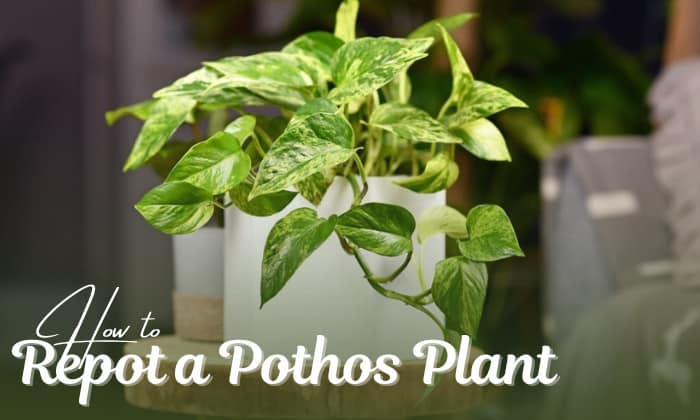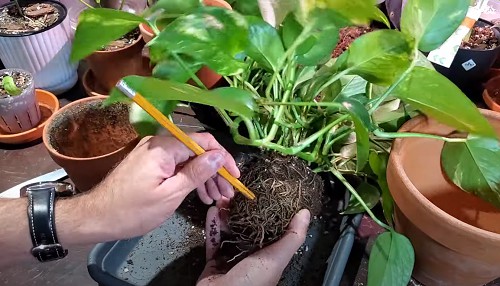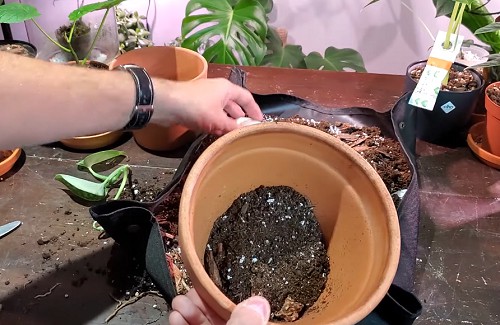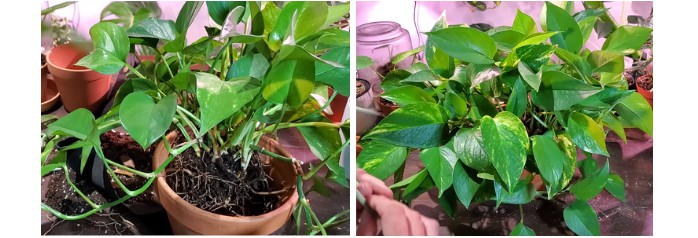Pothos plants do not need direct light to thrive, making them a terrific option for homeowners who lack outdoor space for gardening.
But to preserve the beauty of these tropical plants, you must know how to repot a pothos plant regardless of the variety. In this case, read through the steps below.
Table of Contents
Step-by-step to Repot a Pothos Plant
Prepare before repotting
- Pothos potting soil
The potting soil for pothos should be well-drained and loamy. To create one, combine equal parts of potting soil and perlite or mix equal amounts of pine bark and perlite with twice as much peat moss.
Commercial mixes for this tropical plant type are also available, such as those from Perfect Plants or Gardenera.
- A new container and tray for catching water
Prepare a new container with drain holes at the bottom. When it comes to materials, terracotta, plastic, or ceramic will all work.
Terracotta and ceramic are similar in that they’re durable, though these materials are heavier and may dry quicker than plastic, which is great if you’re prone to overwatering.
Materials aside, the pothos pot size should be two to three inches bigger than your old one so that the plant has space to spread.
You should also prepare a pair of shears and 70-100% rubbing alcohol for trimming the plant, plus a watering can.
Detailed steps for repotting pothos
Step 1 # Remove the pothos plant from its container.
Squeeze the container or turn it over to pull the plant out. Make sure to grab the base of the pothos instead of the foliage, and shake off the old soil as much as possible.
Step 2 # Clean the roots and cut off dead sections.
Look for brown, mushy roots and remove them with sanitized shears. If the root ball is too dense and compact, loosen it with your fingers before trimming.
Remember to disinfect the shears between cuts and wash the plant roots under a faucet before proceeding to the next step.
Step 3 # Transplant pothos into the new container.
Put two inches of the plant mix into your new pot, then place the pothos into the middle of the container.
Bury the roots but not the foliage to minimize root rot, and backfill the container just enough so that the soil doesn’t come too close to the rim and spill out. Allow for two inches of space below the rim.
Step 4 # Care for the plant.
Press the soil to eliminate air pockets and water it until moisture comes out of the drain holes. Catch the excess liquid with the tray you prepared, but do not let the plant sit in it for too long. Dump the water immediately.
To minimize pothos repotting shock, return it to its old spot under indirect sunlight and water only when the soil becomes dry. Avoid fertilizing the plant for at least a month or even longer until it has adapted to its new container.
Since all pothos varieties have similar growing requirements, the tips here should apply whether you repot golden pothos or a jade one. It’s also possible to put different cultivars into the same container, such as Manjula, neon, and golden pothos repotting in an 8-inch pot.
The Importance of Repotting a Pothos Plant
Pothos replanting is vital for several reasons:
- Roots that outgrew their container cannot absorb water and nutrients properly.
- If the soil is too dense, soggy, or holding fungi that cause rot, the plant will become unhealthy and may even die.
- All soils decline in quality over time, requiring replacement every three to four years on average.
- Pests that are present in the soil may be impossible to eliminate, even with chemicals, making repotting the only possible recourse.
FAQs
When to repot a pothos?
Spring or summer is the ideal time for transplanting pothos plants, since these are their growing seasons, and the active plant roots will experience less disturbance, unlike plants that are repotted in winter during dormancy.
Unless your pothos is dying, hold off repotting until spring. And take note of the following situations, for which a change in container is necessary:
- The roots are coming out of the container, or there are less than two inches of space around the root ball.
- It’s been one or two weeks since you’ve brought your plant home from a nursery. The pothos has adapted to its new environment and is ready to accept a new pot.
- Your houseplant does not grow at all, despite not going through dormancy.
How often to repot?
How often to repot pothos depends on its growth rate, and you can observe the plant to look for signs of constriction, illness, or stagnant development. Generally, once every one to two years is an appropriate rule.
How to propagate pothos plants?
A straightforward propagation method is to repot pothos cuttings. Cut from the plant a stem with at least two leaves and three nodes.
Put the cutting in water under indirect sunlight with the bottom node submerged, and wait for plant roots to form within ten days or so.
You should move the cutting from water to soil afterward. Use the potting medium we mentioned above, or opt for potting pothos cuttings in soil right from the beginning and eliminate rooting in water from the process.
Simply dip the stem’s bottom into a rooting hormone then plant it in soil.
Conclusion
After learning how to repot a pothos plant, you should have less trouble keeping it thriving in your home for up to ten years. With their various colors and leaf patterns, your pots for pothos should be a delightful sight on your bookshelf or windowsill. Just remember to put them somewhere as warm as 70 to 80℉.
Other Repotting Guides:
- How to Repot a Venus Flytrap: A Step-by-Step Guide
- The Ultimate Guide to Repotting Boston Ferns
- How to Repot a Bonsai Tree: A Beginner’s Guide

Hi, I am William – Floridayards’ digital content creator. My job is to find answers to all your concerns with thorough research and our team’s expert advice. I will also bring you honest reviews on the best products and equipment for raising your beautiful garden. Please look forward to our work!















